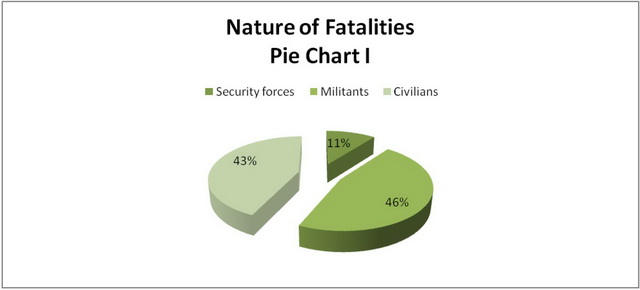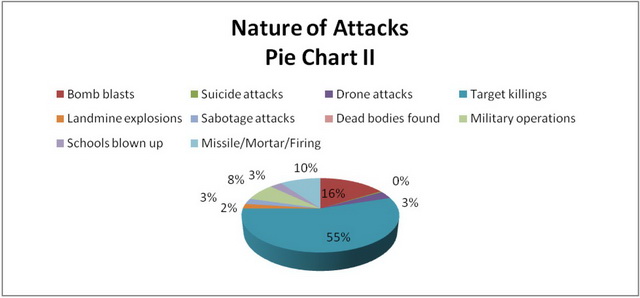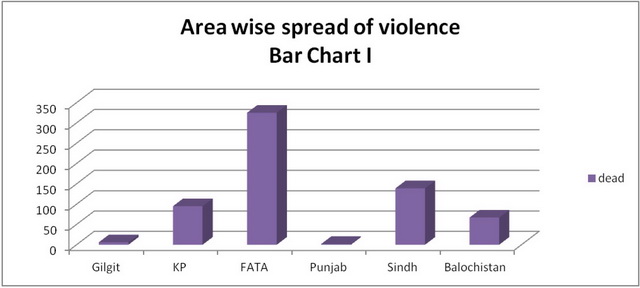The wave of deadly violence picked up considerably during the month of August across Pakistan. Ethno-political violence in Karachi, religio-terrorism in Federally Administered Tribal Areas (FATA) and Khyber Pakhtunkhwa (KP), and nationalist-separatist violence in Balochistan continued to undermine the security landscape in Pakistan. The militancy stricken FATA and KP remained the ground-zero of violence during the current month, wherein a whopping 420 persons lost their lives in different circumstances. The data collected throughten newspapers (that CRSS uses as the source) suggests that some 637 people lost their lives in 240 incidents of violence across the country (for details see data sheet). The violent clashes also left 441 people injured.
Keen analysis of the casualty figures underscores that the militants fighting against the state bore the maximum brunt of violence as 46 percent (295) of the total death toll was of militants. Clashes also left 67 security forces– personnel (11 percent of total deaths) dead, where these deaths were mostly recorded in insurgency infested areas of FATA and Balochistan. Moreover, the data suggests that the civilians remained the second major target of violent actors, with the civilians accounting for 2/5 of the total deaths in various acts of violence and terror across Pakistan. As noted in pie chart I below, civilian deaths comprised of 43 percent of the total death toll. The figure of the civilian deaths is slightly lower than the previous month, where 58 percent of the total dead were innocent civilians. As a whole, 275 civilians were killed in different circumstances during the month. Furthermore, from July 27 to August 30, eight CIA operated drone strikes were reported in different areas of North Waziristan Agency (FATA), leaving as many as 54 suspected militants dead. Figures suggest that August saw the highest number of drone strikes since October 2011. On the contrary, during last month, three drone attacks were reported. Between March and August of this year, 29 drone attacks have resulted in the decimation of 221 suspected militants. Meanwhile, continuing their sabotage campaign to demolish state infrastructure, militants blew up seven government schools in different parts of FATA and KP during the course of month. Also, six sabotage attacks were reported in parts of KP and Balochistan provinces, wherein miscreants blew up two power pylons anda portion of railway track.
During the current month, deadly clashes between military and militants was the major cause of deaths. As a result, as many as 224 persons perished, including 195 militants, 19 security forces– personnel coupled with 10 civilians in different parts of KP and FATA. Meanwhile, target-killing remains the preferred weapon in the hands of violent actors. Pie chart II below depicts that 55 percent of all the violent incidents were of target killing in nature, accounting for 28 percent of the total deaths. Numerically, 180 persons were shot dead across Pakistan, as a result of 132 incidents of violence. Karachi witnessed the major loss of lives as a result of target killings, wherein 105 persons (58 percent of the total dead in target killings, while 16 percent of the total death toll) were assassinated during the month under review. Meanwhile, in August, 59 dead bodies were also recovered from different parts of Pakistan where most of them were found in Karachi, Peshawar and Balochistan. The third major cause of the violence were the missile, mortar and grenade attacks. In total, 56 persons including 11 civilians, 11 security forces– personnel and 34 militants perished in this form of attacks. Likewise, one suicide attack left five people dead and eight others injured in Quetta (Balochistan).
A concise look into the intensity of violence across the country suggests that FATA witnessed major wave of violence in recent months, wherein more than 325 persons were butchered during August (as shown in bar chart I). After FATA, Karachi turned out to be the major hub of violence, where ethno-political violence, unleashed since March, left almost 130 people dead during the current month. Also, violence across KP and Balochistan surged substantially during the course of the month.
Furthermore, the periodic waves of sectarian violence continued to make the minority Shia Muslims toil and bleed. During the current month, 37 people (six percent of all the dead) were killed out of sectarian motives; 34 belonging to Shia minority sect and three (Sunni Muslims) at Babusar Top (KP), Quetta (Balochistan) and Karachi (Sindh), as a result of 10 violent incidents. Latest trends in sectarian violence in Pakistan suggest that the violence significantly gaining pace despite the government’s claims of curtailing it. Shias living in Quetta and Gilgit Baltistan (GB) are frequently falling an easy prey to sectarian militants, who are at the rampage in these two locations due to the prevalent security vacuum.
Accumulative data of last three months (June-August) shows that 1700 people have perished across Pakistan as a result of the ongoing wave of violence. Among these, August was the most violent month, wherein large numbers of deaths occurred due to the clashes between military and militants and spree of target killings in FATA, KP and Karachi. The salient features of the month were militants– attack on Kamra Airbase near Islamabad, eight drone attacks in FATA – which killed 54 suspected militants, and two ferocious sectarian attacks against Shia men in Quetta and KP. Overall security situation continues to deteriorate, with multiple internal and external factors playing out badly in the country. Local and foreign militants continue to mount attacks against Pakistani security forces on Pak-Afghan border and against sensitive military installations deep inside the country.
The trend underscores that though military succeeded in forcing militants out of some areas as a result of number of military operations (Malakand and South Waziristan operations in 2009), yet strength of militants to strike back is least damaged. Also, ironically, at a time when state and society continue to bleed due to the ongoing violence, the political leadership looks indifferent as ever. Rather it has contended itself in making headlines in the media, showing its concern and creating sensitization by announcing that it knows all the hands behind the violence in the country. From the onset of militancy in Pakistan, different governments have failed miserably in putting together a nuanced and effective policy to counter it whereas handed over the matter to state security establishment, to conceive and execute policy.
Sources
- The News
- Dawn
- The Express Tribune
- Pakistan Today
- Daily Times
- The Frontier Post
- Jang (Urdu)
- Daily Mashriq (Urdu)
- Aaj (Urdu)
- The Nation





